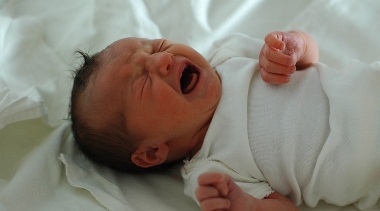The crying of babies exhibits characteristic melodic patterns influenced typically by their mother’s language, finds a study.
During the last quarter of pregnancy, the babies get ample opportunity to become acquainted with their “mother language”.
The findings showed that neonates exhibit in their crying characteristic melodic patterns influenced by their environment – precisely by the language spoken by their mother, and that too even before they coo their first sounds or try out speech-like “syllabic babbling”.
“Building blocks for the development of the future language are acquired from the moment of birth, and not only when infants begin to babble, or to produce their first words,” said Kathleen Wermke, professor at the University of Wurzburg in Germany.
Further, the phenomenon seems to be especially apparent in tonal languages like Mandarin – China’s official language – or Lamnso, the language of the Nso in Cameroon – where pitch and pitch fluctuation determine the meaning of words.
If a pregnant woman speaks such complex tonal languages, it will show in the crying of their newborn infants.
“The crying of neonates whose mothers speak a tonal language is characterised by a significantly higher melodic variation as compared to – for example – German neonates,” Wermke added.
For the study, the team examined 55 babies from China and 21 from Nso in Cameroon, and their cry utterances were recorded during their first days of life.
The infants of the ‘Nso’ in Cameroon exhibited not only a significantly higher “intra-utterance overall pitch variation” – the interval between the highest and the lowest tone – their short-term rise and fall of tones during a cry utterance was more intensive in comparison with the neonates of German-speaking mothers.
“Their crying sounds more like chanting,” Wermke noted.
In addition, the study also highlights that neonates exhibit a high degree of cross-cultural universality in their crying.
These results could even suggest that genetic factors are involved in the process in addition to external factors, the researchers said.
“Of course, it remains undisputed that neonates are able to learn any language spoken in the world, no matter how complex it is,” Wermke pointed out.
The study also improved the possibility to identify early indicators that provide reliable information about any developmental disorders in this field at a very early stage, said the paper published in the the journals Speech, Language and Hearing and Journal of Voice.
- Lanka’s post-attacks nightlife loses fizz
- On a film clip from The Godfather Part II
- Google unveils Pixel 3a, 3a XL
- Kavinda wants govt to acquire sharia university
- Federer near flawless in clay comeback
- Ignoring security warnings led to Easter Sunday attacks – Kiriella
- Blast in Lahore kills at least four, wounds 24
- Govt says cannot keep schools closed
- PM wants sophisticated technology to face global terror
- Facebook building privacy-focused social platform, says Mark Zuckerberg


Leave a comment